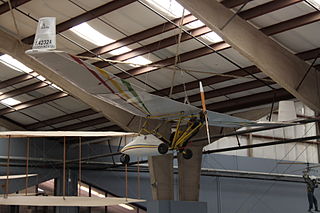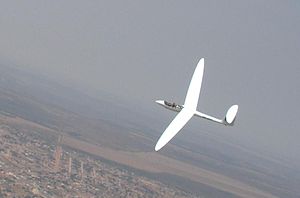The ACME Anser was an amphibious twin-jet utility aircraft that was developed in the United States by Air Craft Marine Engineering in 1958. The project was cancelled before the prototype was complete.

The Schempp-Hirth Cirrus is an Open Class glider built by Schempp-Hirth between 1967 and 1971 and by VTC until 1977. It was replaced by the Nimbus 2.

The Schempp-Hirth Nimbus-4 is a family of high-performance FAI Open Class gliders designed by Klaus Holighaus and manufactured by Schempp-Hirth Flugzeugbau GmbH in Kirchheim, Germany. The Nimbus-4 first flew in 1990.

The Cozy III is a 3-seat, single engine, homebuilt light aircraft designed by Nat Puffer. The aircraft is built from plans using basic raw materials. It is not a kit aircraft, though many small parts are available prefabricated. The Cozy is similar in design and construction to the 2-seat Rutan Long-EZ, from which it is derived, with approval from Burt Rutan.

The SZD-24 Foka (Seal) was a single-seat high performance aerobatic glider designed and built in Poland in 1960.

The EDRA Aeronautica Super Pétrel is an amphibious pusher configuration biplane, seating two side-by-side, brought into production in Brazil in 2002 though with French parentage. It remained in production in 2011, in kit and flyaway forms.
The Akaflieg Darmstadt D-34 sailplanes were a series of experimental single seat sailplanes, designed at the University of Darmstadt in the 1950s and early 1960s to explore the structural and aerodynamic advantages of the then emerging plastics and composite materials.
The Akaflieg Darmstadt D-39 was a single-seat motor glider derived from the D-38 sailplane. Built in Germany in the late 1970s, it was not intended for production and only one was constructed.

The Bréguet Br 905 Fauvette is a single-seat, standard class, competition sailplane, designed and produced in France from the late 1950s. Some 50 were built but most remained grounded after a structural accident in 1969; a few remain airworthy.

The SZD-42 Jantar 2 is a single seat Open Class competition glider, designed and produced in Poland in the 1970s. It features a span of over 20 m (66 ft) and elastic, camber changing flaps. It was placed second, third and seventh at the 1976 World Gliding Championships. Over one hundred were built and more than ninety remain registered.

The Mistral-C was one of the first gliders, designed in 1974 to the then new Club Class rules. It was based on the Strauber Mistral, a Standard Class glider flown a year earlier, but with a new wing and built from newer composite materials. Both types were designed and constructed in Germany. More than 75 Mistral-Cs were produced.
The Smith X-99 Prop-Jet was a six-seat turboprop powered business aircraft designed in the United States in the 1980s. Only one was built.
The VTC Delfin is a competition single seat Standard class glider designed and built in Yugoslavia in the 1960s. It had some success in national competitions and went into small scale production.

The Mitchell Wing B-10 is an American high-wing, open cockpit, single-seat ultralight aircraft and motor glider designed by Don Mitchell and based on his Mitchell Wing hang-glider. It has been produced by a variety of companies in the form of kits and plans for amateur construction.
The Teichfuss Cicogna was an Italian tailless single-seat motor glider designed by Luigi Teichfuss and flown in 1936.
The Bagalini Bagalini is an Italian homebuilt ultralight aircraft that was designed by Marino Bagalini. The aircraft is supplied in the form of plans for amateur construction.
The VFW-Fokker FK-3 is a single seat competition glider, built in Germany in the late 1960s. It had success at the Italian and Austrian national contests of 1968, resulting in a short production run the following year.

The Orlican VT-16 Orlik is a single-seat club glider, serving Czech gliding clubs and setting several national records in the early 1960s.
The MAI-60 was an FAI Standard Class, single seat sailplane designed and built in the USSR in the early 1960s. It suffered from both aerodynamic and structural problems and did not reach production.
The IPD Urubu also known as the IPD/PAR PE 80367, was a two-seat sailplane of high-wing.










